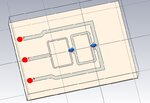mr_evo
Junior Member level 1

Good afternoon!
Recently I've calculated WPD parameters. Then it was obtained simulation results of schematic circuit. Now I'm trying to create the structure in field representation, but simulation results are different. What can be the reason?
please have a look on attached pictures.


I think output lines make the influence. How to reduce it?
Recently I've calculated WPD parameters. Then it was obtained simulation results of schematic circuit. Now I'm trying to create the structure in field representation, but simulation results are different. What can be the reason?
please have a look on attached pictures.



I think output lines make the influence. How to reduce it?
Last edited:



